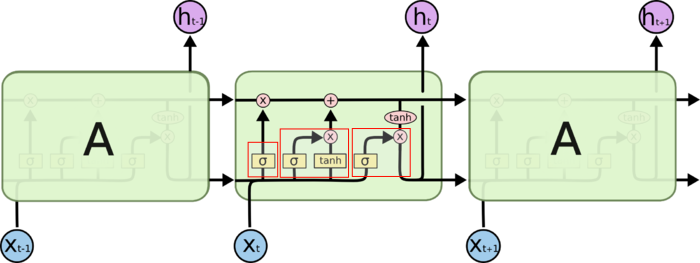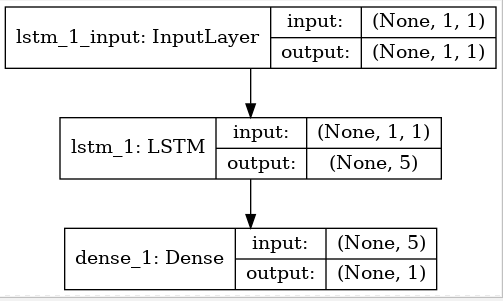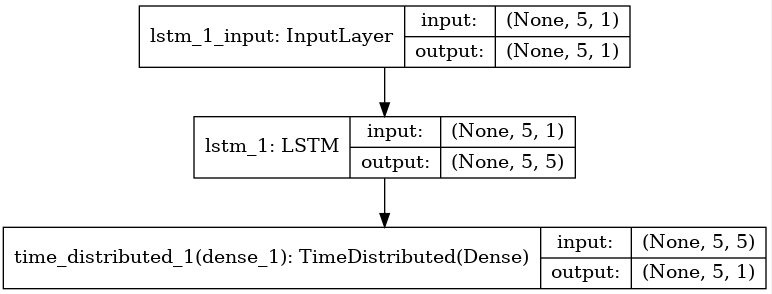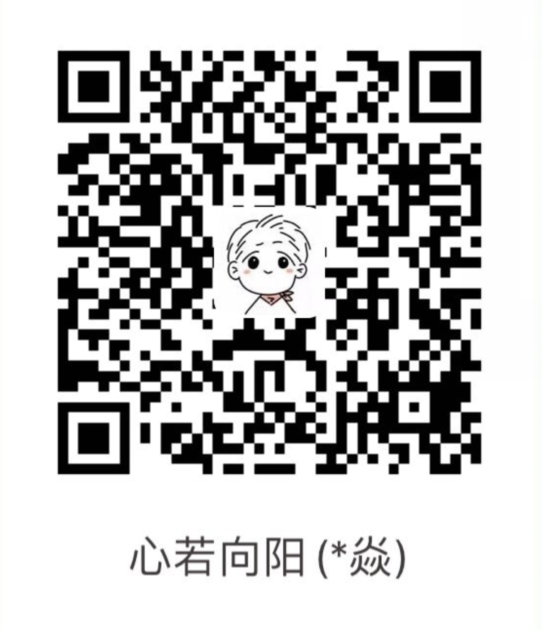
前言
本篇主要讲 LSTM 的参数计算和 Keras TimeDistributed 层的使用。LSTM 的输入格式为:[Simples,Time Steps,Features]
- Samples. One sequence is one sample. A batch is comprised of one or more samples.(就是有几条数据)
- Time Steps. One time step is one point of observation in the sample.(时间步长,通常对应时间序列的长度)
- Features. One feature is one observation at a time step.(一个时间步长对应的向量长度)
举个文本的例子,原始一个 batch_size=50, 一行文本的长度 max_len=10, 所以输入矩阵为 [50,10],embedding 成 300 维的向量后,格式为 [50,10,300],分别对应 Simples,Time Steps,Features。
另外一个需要设置的参数是 LSTM 的输出维度 (Output_dim),比如为 128,LSTM 的参数量计算为
计算 LSTM 层的参数
上面计算 LSTM 参数数目的方法是怎么来的呢?首先理解 RNN 权重共享。对于 LSTM,cell 的权重是共享的,这是什么意思呢?这是指图片上三个绿色的大框,即三个 cell ,但是实际上,它只是代表了一个 cell 在不同时序时候的状态,所有的数据只会通过一个 cell,然后不断更新它的权重。
我们现在来考虑遗忘门:

图中的公式 $h{t-1}$ 的长度是 Output_dim, $[h{t-1},x{t}]$ 的长度就是 Output_dim+Features, $W{f}$ 和 $b{f}$ 为该层的参数。 $W{f}$ 的大小为 (Outputdim+Features)xOutput_dim,$b{f}$ 的大小为 Output_dim,所以这个门总的参数为:

同样的更新门,有两倍的遗忘门参数。

更新过程中没有参数需要学习。

输出门参数和遗忘门一样多。
一对一序列预测
首先做一个序列的问题,假设有数据 X 和数据如下,然后用 LSTM 做序列预测:
1
2
| X:[ 0. 0.2 0.4 0.6 0.8]
Y:[ 0. 0.2 0.4 0.6 0.8]
|
代码很简单,结果正确:
1
2
3
4
5
6
7
8
9
10
11
12
13
14
15
16
17
18
19
20
21
22
23
24
25
| from keras.models import Sequential
from keras.layers import Dense
from keras.layers import LSTM
from numpy import array
length = 5
seq = array([i/float(length) for i in range(length)])
X = seq.reshape(len(seq), 1, 1)
y = seq.reshape(len(seq), 1)
n_neurons = length
n_batch = length
n_epoch = 1000
model = Sequential()
model.add(LSTM(n_neurons, input_shape=(1, 1)))
model.add(Dense(1))
model.compile(loss='mean_squared_error', optimizer='adam')
print(model.summary())
model.fit(X, y, epochs=n_epoch, batch_size=n_batch, verbose=2)
result = model.predict(X, batch_size=n_batch, verbose=0)
for value in result:
print('%.1f' % value)
|
下面我们来手动计算一下LSTM层的参数:
1
2
3
4
| n = 4 * ((inputs + 1) * outputs + outputs^2)
n = 4 * ((1 + 1) * 5 + 5^2)
n = 4 * 35
n = 140
|
全连接层的参数计算如下:
1
2
3
| n = inputs * outputs + outputs
n = 5 * 1 + 1
n = 6
|
和Keras打印的参数一致:
1
2
3
4
5
6
7
8
9
10
11
| _________________________________________________________________
Layer (type) Output Shape Param
=================================================================
lstm_1 (LSTM) (None, 1, 5) 140
_________________________________________________________________
dense_1 (Dense) (None, 1, 1) 6
=================================================================
Total params: 146.0
Trainable params: 146
Non-trainable params: 0.0
_________________________________________________________________
|
模型的结构图如下:

多对一序列预测
同样准备数据:
1
2
3
4
5
6
| X1: 0
X2: 0.2
X3: 0.4
X4: 0.6
X5: 0.8
Y :[ 0. 0.2 0.4 0.6 0.8]
|
代码如下:
1
2
3
4
5
6
7
8
9
10
11
12
13
14
15
16
17
18
19
20
21
22
23
24
25
| from numpy import array
from keras.models import Sequential
from keras.layers import Dense
from keras.layers import LSTM
length = 5
seq = array([i/float(length) for i in range(length)])
X = seq.reshape(1, length, 1)
y = seq.reshape(1, length)
n_neurons = length
n_batch = 1
n_epoch = 500
model = Sequential()
model.add(LSTM(n_neurons, input_shape=(length, 1)))
model.add(Dense(length))
model.compile(loss='mean_squared_error', optimizer='adam')
print(model.summary())
model.fit(X, y, epochs=n_epoch, batch_size=n_batch, verbose=2)
result = model.predict(X, batch_size=n_batch, verbose=0)
for value in result[0,:]:
print('%.1f' % value)
|
用Keras打印网络结构如下:
1
2
3
4
5
6
7
8
9
10
11
| _________________________________________________________________
Layer (type) Output Shape Param
=================================================================
lstm_1 (LSTM) (None, 5) 140
_________________________________________________________________
dense_1 (Dense) (None, 5) 30
=================================================================
Total params: 170.0
Trainable params: 170
Non-trainable params: 0.0
_________________________________________________________________
|
这一次的参数有170个。原因是全连接层参数变多了,计算如下;
1
2
3
| n = inputs * outputs + outputs
n = 5 * 5 + 5
n = 30
|
整体的模型结构如下:

带 TimeDistributed 的多对多 LSTM 序列预测
1
2
3
4
5
6
7
8
9
10
11
12
13
14
15
16
17
18
19
20
21
22
23
24
25
26
| from numpy import array
from keras.models import Sequential
from keras.layers import Dense
from keras.layers import TimeDistributed
from keras.layers import LSTM
length = 5
seq = array([i/float(length) for i in range(length)])
X = seq.reshape(1, length, 1)
y = seq.reshape(1, length, 1)
n_neurons = length
n_batch = 1
n_epoch = 1000
model = Sequential()
model.add(LSTM(n_neurons, input_shape=(length, 1), return_sequences=True))
model.add(TimeDistributed(Dense(1)))
model.compile(loss='mean_squared_error', optimizer='adam')
print(model.summary())
model.fit(X, y, epochs=n_epoch, batch_size=n_batch, verbose=2)
result = model.predict(X, batch_size=n_batch, verbose=0)
for value in result[0,:,0]:
print('%.1f' % value)
|
用 Keras 打印网络结构如下:
1
2
3
4
5
6
7
8
9
10
11
| _________________________________________________________________
Layer (type) Output Shape Param
=================================================================
lstm_1 (LSTM) (None, 5, 5) 140
_________________________________________________________________
time_distributed_1 (TimeDist (None, 5, 1) 6
=================================================================
Total params: 146.0
Trainable params: 146
Non-trainable params: 0.0
_________________________________________________________________
|
整体的模型结构如下:

Reference
- How to Use the TimeDistributed Layer for Long Short-Term Memory Networks in Python









